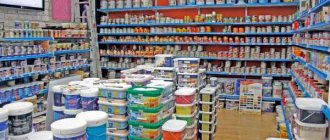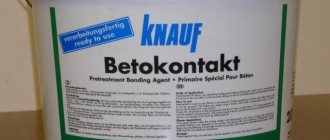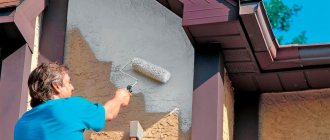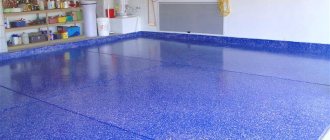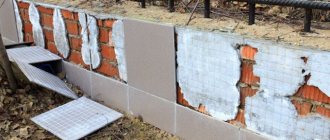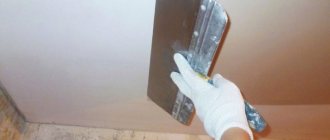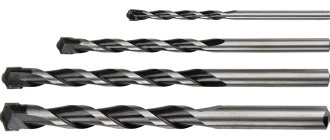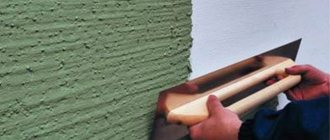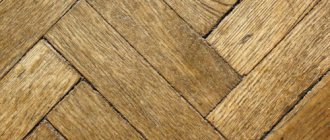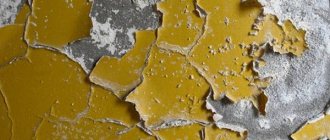Facade paint must have properties that allow the coating not to deteriorate, maintain decorativeness, strength, and durability.
For a concrete coating, you must choose a paint that will have good adhesive qualities.
Paint for exterior painting on concrete surfaces protects the wall from moisture and the occurrence of mold and fungi.
Therefore, the main indicator when choosing facade paint for exterior work should be its quality characteristics.
Features of concrete surface
Concrete is one of the oldest building materials. Previously, the material consisted of sand and lime, now its main component is cement.
The concrete surface has a rather boring and gray appearance; most often it is refined with various facing materials.
The concrete base has increased porosity and roughness , it can absorb a lot of moisture and retain it in the surface layer, so to protect it, paint that has good adhesion to the surface is required.
Despite the fact that the concrete surface requires additional finishing, the material is very strong, stable and durable.
What properties should concrete paint have?
Since concrete walls are quite capricious, the requirements for dyes for such surfaces should be increased:
- adhesive properties . Facade paints must have a high penetrating ability for deep adhesion to the surface. To improve these properties of painting materials, it is recommended to prime the surface before painting;
- moisture resistance . Considering the ability of a concrete coating to absorb moisture, manufacturers add special additives to painting materials that can repel water. The higher this ability, the better the paint;
- wear resistance An important indicator that characterizes the service life of the dye is its abrasion. The more aggressive influences a coloring material can withstand, the higher its endurance rating;
- resistance to solar radiation . Ultraviolet radiation negatively affects the color pigment of the paint: with a low sun resistance, the paint quickly loses its color saturation, brightness and attractiveness, and can peel off. Exterior paints must have high resistance to sunlight;
- vapor permeability . The chemical composition of paints must be designed in such a way as to have the ability to release accumulated moisture. Considering that concrete easily absorbs moisture, if the coating is completely sealed, it will accumulate between the surface and the coating, which will lead to the destruction of the dye and base during temperature fluctuations;
- resistance to stains . Most paints have good stain resistance: they are not able to absorb dirt and are easy to clean. The smoother the painted surface, the less susceptible it will be to the accumulation of dust and dirt;
- drying time . Drying the outer paint material as quickly as possible ensures the least chance of exposure to rain; the faster the paint dries, the better;
- consumption per 1m2 . Concrete requires a large consumption of dye, so you should start from the characteristics of the chosen paint;
- saturation _ The indicator is directly related to consumption: the higher the saturation, the lower the consumption. The concrete base requires complete painting, since the gray reflections of the coating are not aesthetically pleasing and unattractive.
NOTE!
Due to the increase in strength and wear resistance, exterior paints may contain some elements harmful to health.
In this regard, it should be borne in mind that such paints are not suitable for indoor use.
Types of painting compositions for ceilings
Experts recommend that before carrying out renovations in a room, consider compositions without substances harmful to health.
The choice of suitable paint is carried out taking into account the purpose of the room, the condition of the surface, and the requirements for the appearance of the coating.
Silicone
Water-dispersed composition with silicone resins as a base. Due to its environmental friendliness and lack of odor, it can be used in an apartment.
The silicone composition of the paint is more resistant to abrasion.
Advantages:
- resistance to moisture;
- vapor permeability;
- long service life (up to 25 years);
- elasticity (can bridge gaps up to 2 mm);
- resistance to sunlight.
Epoxy
A two-component composition that forms a film on the surface after drying.
Advantages:
- the composition is easy to prepare (the ingredients are mixed);
- is moisture resistant;
- can be used for painting surfaces in non-residential premises (garage);
- bright rich color;
- service life is 30-40 years.
Disadvantage: limited color range.
Silicate
The base is liquid glass.
Advantages:
- moisture resistance;
- resistance to sunlight;
- vapor permeability;
- ability to withstand sudden temperature changes;
- antiseptic qualities (prevention of fungi, mold).
Painting the ceiling with silicate paint.
Alkyd
The starting material is polyester resins. The composition based on alkyd resins has a pungent odor and takes a long time to dry.
Pay attention to: Painting walls with water-based paint: surface preparation, choice of paint and step-by-step instructions for painting
Advantages:
- moisture resistance;
- light fastness;
- resistance to cracks;
- variety of colors;
- possibility of obtaining a matte or glossy surface.
Flaws:
- contains toxic substances;
- low vapor permeability;
- fire hazard.
Acrylic
Consists of acrylic resins and diluted polymers. Depending on the concentration of ingredients, it can be matte or glossy. After application, a film forms on the surface.
Acrylic paint is very durable.
In demand due to:
- resistance to moisture;
- ability to withstand temperature changes;
- quick drying (30-120 minutes);
- no odor.
Used for coloring:
- poorly heated rooms;
- outbuildings;
- gyms;
- garages.
What paints are suitable for painting a concrete facade?
There are several types of dyes that are used to coat concrete facades.
These include coatings that meet the requirements for the operation of external cladding materials.
Painting coatings for concrete bases are classified according to their composition:
- acrylic _ The composition includes polymers and polyacrylates. A variety is latex cladding. The paints are resistant to moisture, wear-resistant, free of harmful impurities, and elastic. They have poor frost resistance and are quite expensive;
- water-epoxy . They are universal not only for concrete surfaces, but also for others. They have high moisture resistance. It is not recommended to use in places of frequent sun exposure: there is a high probability of weakening the color brightness;
- polymer . They have good wear resistance, withstand both high and low temperatures, and are resistant to aggressive chemical compounds. They have a long drying time and are quite expensive;
- vinyl _ They are capable of quite effectively painting a concrete surface with one layer, are varied in color, and are quite wear-resistant;
- acrylic-silicone . They are resistant to the sun, have the positive characteristics of acrylic paints, are durable, and are suitable for outdoor and indoor use.
In addition, for the external coating, paints are used that:
- dissolves in water - contains synthetic resins and is environmentally friendly;
- dissolved by organic solvents - contain flammable substances, vapor-tight, less popular.
In addition to the characteristics of paints, according to the composition and method of preparation, there are materials that have a smooth structure (suitable for a perfectly smooth surface) and textured (for surfaces with minor defects), as well as matte and glossy (differ in the nature of the reflection of sunlight).
What paint is best for concrete?
An indicator when choosing a painting material to cover a concrete facade is the ability of the paint to provide vapor permeability. It is important to pay attention to the thickness and consistency of the composition.
For a concrete base, you can choose paints that have a high level of mechanical resistance, namely, water-based epoxy. Paints with a textured structure have better vapor permeability.
In addition, it is recommended to choose paint that reflects light as much as possible: this will minimize the likelihood of fading.
Preparing the base for painting
The concrete surface is characterized by an insufficiently strong top layer, which can affect the quality of painting. In order to ensure maximum adhesion to the wall, a number of measures should be taken to prepare the walls:
- level the surface . To do this, it is necessary to eliminate sharp protrusions, seal seams and cracks;
- clean the base . If there are oil stains, they should be removed with concrete (the thickness of the recess is up to three centimeters), and the recess should be sealed with fresh mortar. Clean the entire surface from dust and debris.
IMPORTANT!
It is recommended to rinse the surface with water from a hose under pressure : this washes out the top thin, fragile layer, which disrupts the adhesion of the paint to the surface.
In addition, strong pressure can wash out the recesses in the wall, which is a positive point: if these places were painted, they would soon fall off anyway, and it would be necessary to seal this place along with the painted layer.
The resulting depressions should be filled with fresh solution and wait until completely dry.
Preparing the concrete base for painting
The quality of painting and the service life of the coating depend on the preparation of the base.
Perform operations including:
- cleansing;
- padding;
- processing of junction points;
- putty;
- alignment;
- dust removal.
Cleansing
Remove old coating (paint, whitewash), dirt, splashes, grease stains, etc. Use a spatula to remove old plaster (especially peeled areas). The surface is washed and dried. Areas affected by mold or mildew are treated with chemicals.
Knocking down sagging and sealing cracks
Floor slabs often have ridges or protrusions. They are removed with a chisel or hammer. The sinks and potholes are cleaned, the cracks are expanded along the length with a scraper. After removing the dust, the recesses are primed and then puttied.
Pay attention to: Cleaning clothes from acrylic paint: methods and means
Surface priming
Ceiling primer.
Before puttying, the surface is primed. It is recommended to use deep penetration compounds (to ensure adhesion of the base and finishing material).
Apply the primer in several layers (after preliminary drying). For application, use a roller; in hard-to-reach places, use a brush.
Concrete base putty
After the primer has dried, they begin to level the ceiling with putty. First, seal the joints between the floor slabs using serpyanka or gypsum putty.
Then apply the starting mixture (no more than 2 cm thick). Start from the corner and spread the composition over the ceiling with a spatula. To fill the recesses, press the spatula firmly against the base.
After drying, the surface is sanded with an abrasive mesh, and a second layer of starting putty is applied. The dried surface is primed to increase the adhesion of coatings (starting and finishing).
The finishing coat is applied with a spatula without applying much pressure. After drying, sand with a fine mesh.
Painting technology
Before applying paint to concrete, the entire surface should be primed . To do this, choose a primer depending on the paint composition used.
The main indicator of high-quality coloring is the degree of rubbing of the coloring material into the surface.
The coloring method plays a big role in this:
- air pistol . This is the best option; with this method, all the pores of the base are filled with paint, which means high-quality adhesion;
- brush _ A suitable option, but it requires careful rubbing of the material into the surface and is characterized by lengthy work and high labor costs. The brush often gets clogged with sand particles, which requires constant wetting it in a solvent - this can contribute to the formation of stains that will require additional coloring;
- roller _ An unsuitable option for concrete: painting occurs only on the surface, and it does not get into the pores of the base, which contributes to weak adhesion and rapid peeling.
Coloring should be done in the following way:
- Painting tape should be used to cover the paint border;
- work must be done from top to bottom;
- The brush should be dipped in such a way that it is covered with an even layer of color coating;
- Using an up-and-down movement of a small trajectory, small areas should be painted.
The paint coating must be distributed evenly over the base . If there are insufficiently painted areas, they need to be painted again.
After complete painting, remove the masking tape and use a thin brush to outline the borders.
Thus, painting the facade will not be difficult. The main thing is to choose the right paint and carefully prepare the surface so that there are no problems later.
Basic methods of paintwork
To apply the coloring composition use:
- brushes;
- rollers;
- spray gun.
Choosing a tool for painting the ceiling.
Painting with a roller takes less time. When choosing a roller, it is recommended to pay attention to the seams of the material (this affects the result of the work).
For textured surfaces and hard-to-reach places, brushes are used. When working with acrylic or latex compositions, use brushes with artificial fibers (organic ones may break down and residual bristles will appear on the surface).
Spray gun
Mechanical or electrical devices allow paint to be applied evenly over the entire surface.
Before carrying out work you should:
- remove furniture from the premises;
- turn off heating radiators;
- open the windows;
- remove sources of open fire;
- Prepare a respirator, safety glasses and gloves.
Pay attention to: Painting metal gates at home: tips for beginners
The spray gun allows you to apply paint evenly to the ceiling.
The sprayer is held perpendicular to the ceiling surface. The length of the jet ranges from 60 to 80 cm. The first layer is applied in longitudinal stripes (each subsequent one overlaps part of the previous one). Errors are hidden with the next layer.
